The Pharmaceutical Plastic Pots Market is estimated to be valued at USD 1.6 billion in 2025 and is projected to reach USD 3.3 billion by 2035, registering a compound annual growth rate (CAGR) of 7.5% over the forecast period.
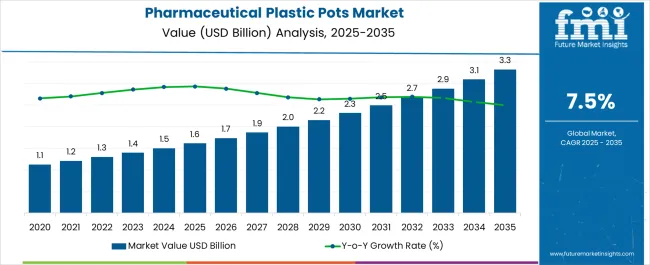
| Metric | Value |
|---|---|
| Pharmaceutical Plastic Pots Market Estimated Value in (2025 E) | USD 1.6 billion |
| Pharmaceutical Plastic Pots Market Forecast Value in (2035 F) | USD 3.3 billion |
| Forecast CAGR (2025 to 2035) | 7.5% |
The Pharmaceutical Plastic Pots market is witnessing steady growth, driven by the increasing demand for safe, durable, and compliant packaging solutions across pharmaceutical and nutraceutical industries. Rising consumer awareness regarding product safety, along with stringent regulatory standards for packaging materials, is fueling adoption of high-quality plastic pots. Advancements in polymer technology have enabled the production of materials that are lightweight, chemically resistant, and suitable for a wide range of pharmaceutical formulations.
The market is further supported by the need for convenient, tamper-evident, and user-friendly packaging solutions that enhance product usability and shelf appeal. Increased investments in healthcare infrastructure, coupled with the expansion of over-the-counter medications and nutraceutical products, are contributing to the demand for versatile packaging formats.
Manufacturers are focusing on offering scalable, customizable, and sustainable packaging options to meet the requirements of diverse pharmaceutical products As the global pharmaceutical industry continues to expand, demand for innovative and compliant plastic pots is expected to grow steadily, with emphasis on efficiency, safety, and sustainability shaping the market landscape.
The pharmaceutical plastic pots market is segmented by material, capacity, closure, and geographic regions. By material, pharmaceutical plastic pots market is divided into PE, PP, PET, and Others. In terms of capacity, pharmaceutical plastic pots market is classified into 500 - 1,500 Ml, <500 Ml, 1,500 - 2,500 Ml, 2,500 - 3,500 Ml, and >3,500 Ml.
Based on closure, pharmaceutical plastic pots market is segmented into Flip Top Cap, Screw Cap, and Others. Regionally, the pharmaceutical plastic pots industry is classified into North America, Latin America, Western Europe, Eastern Europe, Balkan & Baltic Countries, Russia & Belarus, Central Asia, East Asia, South Asia & Pacific, and the Middle East & Africa.
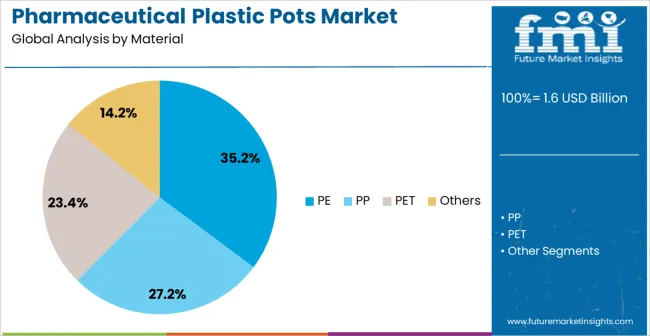
The polyethylene (PE) material segment is projected to hold 35.2% of the market revenue in 2025, establishing it as the leading material type. Growth is being driven by its superior chemical resistance, durability, and cost-effectiveness, making it suitable for a wide variety of pharmaceutical products including tablets, capsules, ointments, and powders. PE provides reliable protection against moisture, light, and contamination, ensuring product stability and shelf life.
The material’s lightweight nature and ease of processing allow manufacturers to optimize production costs while maintaining compliance with regulatory standards. Compatibility with different closure systems and the ability to support printing and labeling further enhance its adoption.
Increasing demand for packaging solutions that balance sustainability and performance has reinforced the preference for PE As manufacturers continue to focus on safe, cost-efficient, and versatile packaging options, the PE material segment is expected to maintain its leading position, supported by ongoing advancements in polymer formulations and processing technologies.
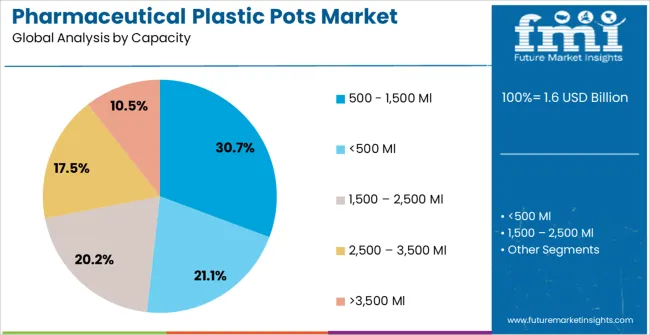
The 500 - 1,500 ml capacity segment is expected to account for 30.7% of the market revenue in 2025, making it the leading capacity category. This growth is being driven by the widespread use of mid-sized pharmaceutical products that require versatile packaging for both consumer convenience and manufacturing efficiency. The capacity range allows for optimal dosing, easy handling, and storage, making it suitable for tablets, capsules, powders, and topical formulations.
It supports efficient production scaling and aligns with logistical and regulatory requirements. Manufacturers prefer this capacity for its balance between usability and material cost efficiency, enabling reduced waste and transportation optimization.
Rising demand from hospitals, pharmacies, and retail outlets, along with the expansion of over-the-counter pharmaceutical products, is reinforcing adoption The 500 - 1,500 ml capacity segment is expected to continue leading the market as it meets both functional and commercial needs, providing flexibility in packaging design and contributing to enhanced supply chain efficiency.
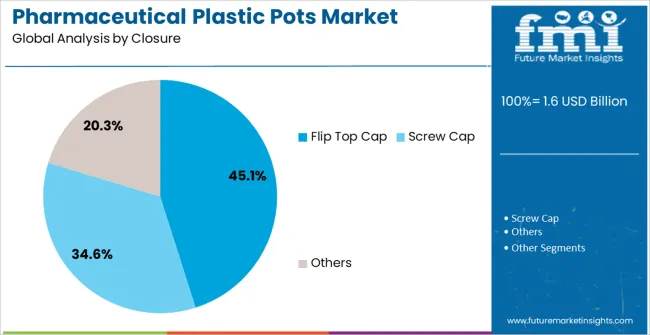
The flip top cap segment is projected to hold 45.1% of the market revenue in 2025, establishing it as the leading closure type. Growth in this segment is being driven by the convenience, ease of use, and tamper-evident features provided by flip top caps, which enhance product safety and user experience. These closures enable controlled dispensing, reduce the risk of contamination, and support secure sealing for various pharmaceutical formulations.
Flip top caps are compatible with a wide range of pot materials and sizes, allowing for flexibility in packaging design and manufacturing processes. Their durability and reliability in protecting contents have made them preferred by both manufacturers and end users.
Rising emphasis on packaging compliance, consumer convenience, and hygienic handling further supports adoption As pharmaceutical companies continue to prioritize user-friendly and safe packaging solutions, the flip top cap segment is expected to maintain its leading market share, reinforced by ongoing innovation in closure designs and material compatibility.
Pharmaceutical plastic pots find applications in medical clinics, hospitals, and other healthcare facilities, as an efficient tamper evident packaging and storage solution. The preference for pharmaceutical plastic pots is high for packaging cosmetic tablets and powders, as they are required to be manufactured under certified process, thereby scoring high on hygiene.
Pharmaceutical plastic pots are customizable and available in a variety of capacities and shapes, which enable them to be used for a wide range of drugs. The special protective design of pharmaceutical plastic pots enable them to be safe for nesting during storage and transportation. Since any packaging solution for the pharmaceutical packaging industry is required to be manufactured under strict guidelines and conditions, pharmaceutical plastic pots are expected to enjoy high preference, over the forecast period.
Numerous countries across the globe are increasing their per capita healthcare expenditure, in addition to improving their quality standard. This presents the global pharmaceutical plastic pots market with lucrative opportunities. Due to all these factors, the global pharmaceutical plastic pots market is expected to have a largely positive outlook, over the forecast period.
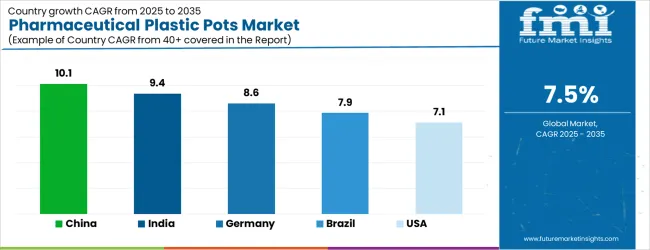
| Country | CAGR |
|---|---|
| China | 10.1% |
| India | 9.4% |
| Germany | 8.6% |
| Brazil | 7.9% |
| USA | 7.1% |
| UK | 6.4% |
| Japan | 5.6% |
The Pharmaceutical Plastic Pots Market is expected to register a CAGR of 7.5% during the forecast period, exhibiting varied country level momentum. China leads with the highest CAGR of 10.1%, followed by India at 9.4%. Developed markets such as Germany, France, and the UK continue to expand steadily, while the USA is likely to grow at consistent rates.
Japan posts the lowest CAGR at 5.6%, yet still underscores a broadly positive trajectory for the global Pharmaceutical Plastic Pots Market. In 2024, Germany held a dominant revenue in the Western Europe market and is expected to grow with a CAGR of 8.6%.
The USA Pharmaceutical Plastic Pots Market is estimated to be valued at USD 551.2 million in 2025 and is anticipated to reach a valuation of USD 551.2 million by 2035. Sales are projected to rise at a CAGR of 0.0% over the forecast period between 2025 and 2035. While Japan and South Korea markets are estimated to be valued at USD 84.4 million and USD 54.9 million respectively in 2025.
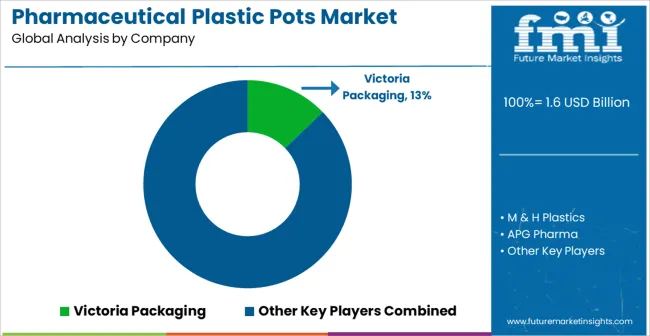
| Item | Value |
|---|---|
| Quantitative Units | USD 1.6 Billion |
| Material | PE, PP, PET, and Others |
| Capacity | 500 - 1,500 Ml, <500 Ml, 1,500 - 2,500 Ml, 2,500 - 3,500 Ml, and >3,500 Ml |
| Closure | Flip Top Cap, Screw Cap, and Others |
| Regions Covered | North America, Europe, Asia-Pacific, Latin America, Middle East & Africa |
| Country Covered | United States, Canada, Germany, France, United Kingdom, China, Japan, India, Brazil, South Africa |
| Key Companies Profiled | Victoria Packaging, M & H Plastics, APG Pharma, Berry Global, Ampac Holdings, Sealed Air, Tekni Plex, Aphena Pharma, Bilcare Research, Constantia Flexibles, AptarGroup, Gerresheimer, and Amcor |
The global pharmaceutical plastic pots market is estimated to be valued at USD 1.6 billion in 2025.
The market size for the pharmaceutical plastic pots market is projected to reach USD 3.3 billion by 2035.
The pharmaceutical plastic pots market is expected to grow at a 7.5% CAGR between 2025 and 2035.
The key product types in pharmaceutical plastic pots market are pe, pp, PET and others.
In terms of capacity, 500 - 1,500 ml segment to command 30.7% share in the pharmaceutical plastic pots market in 2025.






Our Research Products

The "Full Research Suite" delivers actionable market intel, deep dives on markets or technologies, so clients act faster, cut risk, and unlock growth.

The Leaderboard benchmarks and ranks top vendors, classifying them as Established Leaders, Leading Challengers, or Disruptors & Challengers.

Locates where complements amplify value and substitutes erode it, forecasting net impact by horizon

We deliver granular, decision-grade intel: market sizing, 5-year forecasts, pricing, adoption, usage, revenue, and operational KPIs—plus competitor tracking, regulation, and value chains—across 60 countries broadly.

Spot the shifts before they hit your P&L. We track inflection points, adoption curves, pricing moves, and ecosystem plays to show where demand is heading, why it is changing, and what to do next across high-growth markets and disruptive tech

Real-time reads of user behavior. We track shifting priorities, perceptions of today’s and next-gen services, and provider experience, then pace how fast tech moves from trial to adoption, blending buyer, consumer, and channel inputs with social signals (#WhySwitch, #UX).

Partner with our analyst team to build a custom report designed around your business priorities. From analysing market trends to assessing competitors or crafting bespoke datasets, we tailor insights to your needs.
Supplier Intelligence
Discovery & Profiling
Capacity & Footprint
Performance & Risk
Compliance & Governance
Commercial Readiness
Who Supplies Whom
Scorecards & Shortlists
Playbooks & Docs
Category Intelligence
Definition & Scope
Demand & Use Cases
Cost Drivers
Market Structure
Supply Chain Map
Trade & Policy
Operating Norms
Deliverables
Buyer Intelligence
Account Basics
Spend & Scope
Procurement Model
Vendor Requirements
Terms & Policies
Entry Strategy
Pain Points & Triggers
Outputs
Pricing Analysis
Benchmarks
Trends
Should-Cost
Indexation
Landed Cost
Commercial Terms
Deliverables
Brand Analysis
Positioning & Value Prop
Share & Presence
Customer Evidence
Go-to-Market
Digital & Reputation
Compliance & Trust
KPIs & Gaps
Outputs
Full Research Suite comprises of:
Market outlook & trends analysis
Interviews & case studies
Strategic recommendations
Vendor profiles & capabilities analysis
5-year forecasts
8 regions and 60+ country-level data splits
Market segment data splits
12 months of continuous data updates
DELIVERED AS:
PDF EXCEL ONLINE
Pharmaceutical Plastic Bottle Market Forecast and Outlook 2025 to 2035
Pharmaceutical Plastic Packaging Market Size and Share Forecast Outlook 2025 to 2035
Market Share Breakdown of Pharmaceutical Plastic Packaging
Anti-Neoplastic Pharmaceutical Agents Market Report – Growth & Forecast 2025 to 2035
Plastic Fittings and Tubing for Pharmaceutical and Medical Market Size and Share Forecast Outlook 2025 to 2035
Pharmaceutical Autoclave Machine Market Size and Share Forecast Outlook 2025 to 2035
Pharmaceutical Excipient SNAC Market Size and Share Forecast Outlook 2025 to 2035
Plastic Tubes for Effervescent Tablets Market Size and Share Forecast Outlook 2025 to 2035
Pharmaceutical Zinc Powder Market Size and Share Forecast Outlook 2025 to 2035
Plastic Banding Market Size and Share Forecast Outlook 2025 to 2035
Plastic Tube Market Size and Share Forecast Outlook 2025 to 2035
Pharmaceutical Grade Magnesium Sulfate Market Size and Share Forecast Outlook 2025 to 2035
Pharmaceutical Secondary Packaging Market Size and Share Forecast Outlook 2025 to 2035
Pharmaceutical Glass Packaging Market Size and Share Forecast Outlook 2025 to 2035
Plastic Jar Packaging Market Forecast and Outlook 2025 to 2035
Pharmaceutical Manufacturing Equipment Market Forecast and Outlook 2025 to 2035
Plastic Cases Market Size and Share Forecast Outlook 2025 to 2035
Plastic Jar Industry Analysis in the United States Size and Share Forecast Outlook 2025 to 2035
Plastic Cutlery Market Forecast and Outlook 2025 to 2035
Plastic Vial Market Forecast and Outlook 2025 to 2035

Thank you!
You will receive an email from our Business Development Manager. Please be sure to check your SPAM/JUNK folder too.
Chat With
MaRIA